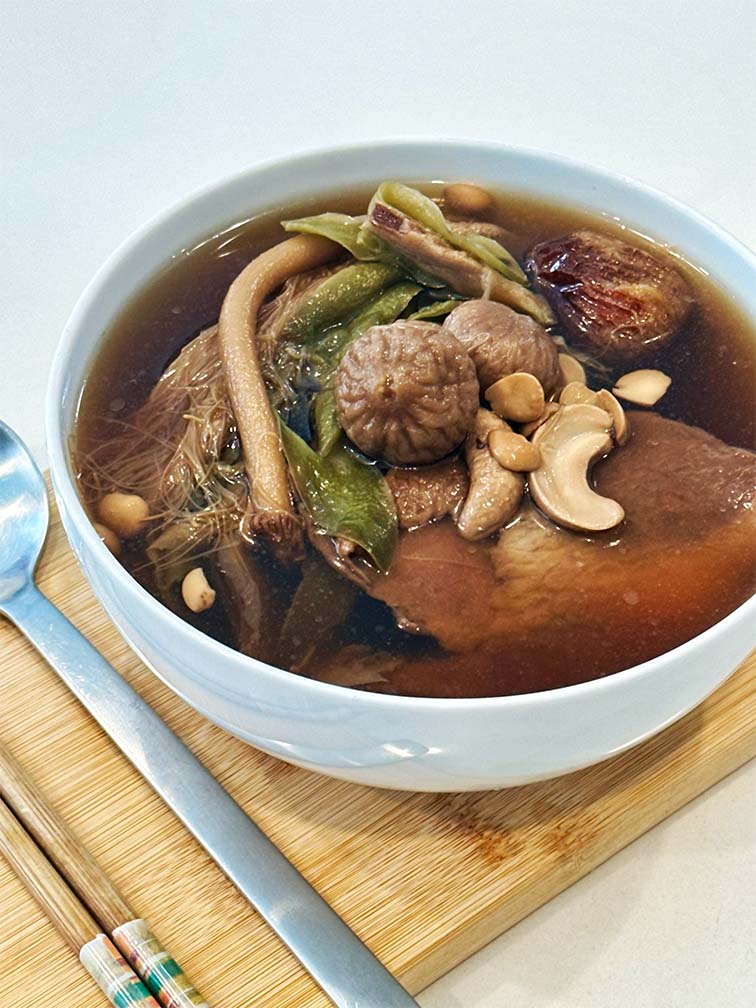REFRESH | Light, Crisp & Comforting
DRIED NIGHT-BLOOMING CACTUS, LILY BULB & CONCH SOUP
DRIED NIGHT-BLOOMING CACTUS, LILY BULB & CONCH SOUP
Couldn't load pickup availability
From now until Dec 26, every order receives a complimentary flower tea sample.
Lightly Sweet & Floral · Calm & Refreshing
A delicately aromatic Hong Kong–style Chinese herbal soup mix made with dried Night-Blooming Cactus (Ba Wong Fa) (霸王花), Lily Bulb (百合), and dried Conch Slices (螺片). Its gentle floral fragrance and lightly sweet flavor create a refreshing and smooth broth that soothes and comforts.
Crafted in Canada with premium dried ingredients, this soup mix is simple to prepare and beautiful to share — a cozy bowl that brings floral freshness and calm to your daily meals.
Cooking Method:
Rinse ingredients lightly. Add about 1.2 L of water, bring to a boil, then simmer for around 2 hours. Season to taste. Suitable for stovetop, pressure cooker, or vacuum-insulated jar cooking.
This is a soup ingredient pack that lets you easily cook and enjoy authentic nourishing Chinese soup at home anytime!
Ingredients
Ingredients
Dried Night-Blooming Cactus (Ba Wong Fa), Dried Conch Slice, Candied Jujube, Dried Lily Bulb, Cashew, Dried Fig, Apricot Kernel
Contains: Tree Nuts (Cashew)
Suitable For
Suitable For
Perfect for anyone who wants an easy way to enjoy authentic Hong Kong style Chinese soup at home whether you’re new to cooking, living a busy lifestyle, or simply looking for a cozy family meal.
Method and Serving Size
Method and Serving Size
Simply rinse the ingredients, place them in a pot, and add water (recommended 1.2 liters). Bring it to a boil over high heat, then change to the lowest heat setting of the smallest stove and simmer for 2 hours. Using the recommended amount of water can yield two large bowls or four regular-sized servings of soup, suitable for a small family.
Other Cooking Methods
Other Cooking Methods
.Cooking Soup with an Instant Pot
Simply rinse the ingredients, place them in the Instant Pot, and add 1.2 liters of water. Set the pot to the Soup mode and cook for 1 hour. After releasing the pressure, you can switch to Sauté mode and simmer for an additional 15 minutes for a richer flavor. This amount of water will yield two large bowls or four regular-sized servings of soup, perfect for a small family.
.Steeping Soup in a Vacuum Insulated Food Jar
Simply rinse the ingredients, place them in a vacuum insulated food jar (recommended size: 750ml), and fill it with hot water. Let it steep for about 4 hours.
Optional Add-on
Optional Add-on
Since the soup is already flavored by the ingredients, there is no need to add additional meat or seasoning when cooking the soup. If you want the soup to be thicker, you can add: Blanched Lean Meat / Blanched Pork Ribs / Corn / Carrot
Storage and Best Before
Storage and Best Before
Please keep in a cool dry place or refrigerator. Avoid high temperature and humidity, or direct sunlight. Recommended to consume within 12 months.
Country of Origin and Packaging
Country of Origin and Packaging
British Columbia, Canada
- Vacuum-sealed: Safe, hygienic, easy to store
- Free shipping: $65+ (Greater Vancouver), $99+ (Canada-wide)
- Sending as a gift? Add a free personalized message card!
The amount of ingredients in the picture is for reference only, the actual amount will be adjusted according to the prepared soup recipe
Share



How to consume soup packet
Learn more about the key Chinese herbs and other traditional ingredients in this soup mix
What is Night-blooming Cereus (Ba Wang Hua) (霸王花)?
Night-blooming Cereus (Ba Wang Hua), also known as “Queen of the Night,” refers to the dried flower of the cactus family plant (Hylocereus undatus or Epiphyllum oxypetalum).
The flower is large, elegant, and fragrant, blooming only briefly at night—hence its Chinese name “曇花一現,” meaning “a fleeting blossom.”
When dried, it appears pale yellow to light brown, with a soft yet resilient texture and a light floral aroma.
When cooked in soup, it releases a subtle fragrance and gentle sweetness, making it one of the most distinctive floral ingredients in Hong Kong–style soups.
Characteristics
According to the Traditional Chinese Medicine Bureau Of Guangdong Provincial, Night-blooming Cereus is sweet and neutral in nature, traditionally used to “clear the heart, moisten the lungs, and relieve summer heat.”*
Its aroma is delicate, and its flavor is mild and refreshing.
When simmered, it adds a natural floral fragrance and subtle sweetness to the broth.
The dried petals absorb flavors easily, blending harmoniously with other soup ingredients.
In Hong Kong households, it is regarded as a classic floral ingredient for soothing, refreshing soups—especially during the summer and early autumn seasons.
Cooking and Pairing Suggestions
- Soup / Stew: Night-blooming Cereus is often paired with lily bulb, fig, Solomon’s Seal Root, or apricot kernels to create a light, aromatic, and naturally sweet soup.
It also pairs beautifully with lean pork or chicken, resulting in a smooth, delicately fragrant broth suitable for all seasons. - Dessert / Herbal Drink: It can be simmered with fig and pear to make a refreshing floral dessert soup or herbal tea—mildly sweet, soothing, and perfect for hot weather.
Interesting to Know
The name “Ba Wang Hua (霸王花),” literally “King of Flowers,” comes from its majestic appearance and powerful presence when it blooms at night.
Its flowering period is short—it typically blossoms between 8 p.m. and midnight, mainly from summer to early autumn.
Because it blooms only once at night and fades by morning, it is carefully harvested and dried to preserve its fragrance and nutritional qualities.
With its natural aroma and light, soothing character, Night-blooming Cereus is a beloved soup ingredient in Cantonese cuisine, especially valued for its cooling and gentle taste during warm seasons.
*Source: Traditional Chinese Medicine Bureau Of Guangdong Provincial. The above information is cited from traditional references and provided for general ingredient knowledge only.
What is Lily Bulb (百合)?
Edible lily bulbs are not made from flower petals — they come from the underground bulbs of plants in the Lilium family. These bulbs are fan-shaped or nearly round, with tightly layered scales resembling white lotus petals — hence the Chinese name “百合,” meaning “a hundred together.” Dried lily bulbs are made by gently dehydrating fresh bulbs at low temperature, extending shelf life and making them convenient for soups and desserts.
Characteristics
According to records in Traditional Chinese Medicine (TCM), lily bulbs are naturally sweet in taste and slightly cool in nature. They have been traditionally used for centuries to nourish yin, moisten the lungs, clear the heart, and calm the mind.*
Their mild and refreshing profile makes them a popular ingredient in autumn and winter soups, especially when paired with snow pear or glehnia root (沙參).
Cooking and Pairing Suggestions
- Fresh lily bulbs are often used in stir-fried dishes such as shrimp or asparagus stir-fry.
- Dried lily bulbs are commonly used in Hong Kong–style soups and desserts, such as Lily Bulb and Snow Fungus Sweet Soup or Lily Bulb and Pear Soup, adding a delicate aroma and gentle natural sweetness. Check out the simple recipe for Chenpi Lotus Seed Dried Lily Bulb Red Bean Tangyuan.
Interesting to Know
In Chinese culture, “Lily” (百合) symbolizes harmony and unity — the phrase “百事合意” means “everything goes smoothly.” Because of this, lily bulbs are often featured in wedding desserts and festive sweet soups.
*Source: Hong Kong Baptist University Chinese Medicinal Material Images Database. The above information is cited from traditional references and provided for general ingredient knowledge only.
What are Apricot Kernels (南北杏)?
Apricot kernels refer to a blend of two types of almond-like seeds from the apricot tree — sweet apricot kernels (南杏) and bitter apricot kernels (北杏). Sweet kernels are typically grown in southern regions, while bitter kernels are mostly produced in the north. Both are oval-shaped and light brown in colour but differ slightly in flavour. Traditionally, the two are mixed in specific ratios and used in Hong Kong–style soups, desserts, and sweet soups to add fragrance and depth of flavour.
Characteristics
Sweet apricot kernels are slightly larger and plumper, with a mild, nutty sweetness and smooth texture. Bitter apricot kernels are smaller and flatter, carrying a faint, bittersweet taste. When combined, they create a rich, balanced aroma. Once cooked, the blend releases a gentle nutty fragrance, giving soups and desserts a light almond aroma — a classic ingredient in many Cantonese-style soup mixes and sweet soups.
Cooking and Pairing Suggestions
- Soups / Stews: Commonly simmered with snow pear, fritillaria bulb, polygonatum root, or fig to create a smooth, aromatic soup.
- Sweet Soups / Desserts: Often cooked with snow fungus, lotus seeds, or lily bulb for a fragrant and delicate almond-flavoured dessert.
- Drinks / Teas: Ground into almond tea or almond milk, known for its silky texture and long-lasting aroma.
Interesting to Know
“南北杏” does not refer to a single plant but a combination of sweet and bitter apricot kernels — both derived from apricot seeds. Their complementary flavours and strong aroma make them a popular base ingredient in Cantonese soups and desserts.
*The above information is provided for general ingredient knowledge only.
We love the new lung care soup. It is good all seasons. I find it super handy and convenient. Hope that there will be more new soups coming in the future!
Thank you so much for your lovely review! ❤️ We’re so happy to hear you enjoyed the Lung Care Soup and found it both healthy and convenient. Your encouragement truly means a lot — we’ll definitely keep working on bringing more new soups your way! 😊
Why You'll Love This Soup Packet
-

NOURISHING & HEALTH-BOOSTING
Carefully blended Chinese herbal ingredients to support your wellness goals.
-

CONVENIENT & TIME-SAVING
Ready-to-cook packets with simple instructions—just add water & simmer!
-

SAFE, FRESH & HYGIENIC
Individually vacuum-sealed to lock in freshness.
-

PERFECTLY PORTIONED
Designed for small families (2 large bowls / 4 regular bowls) to prevent waste.








